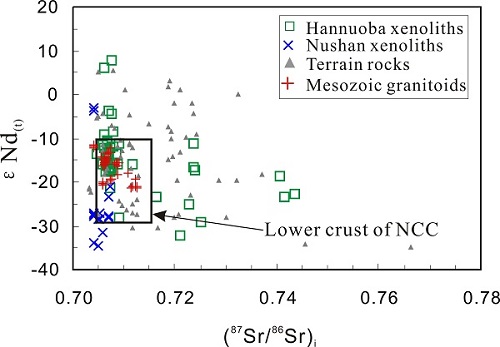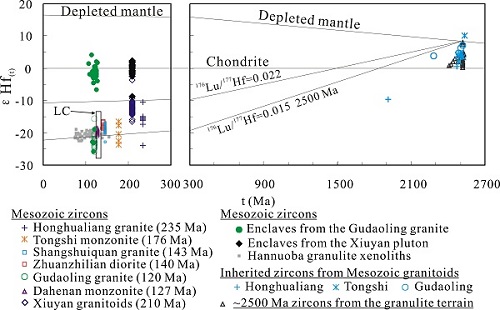Nature and evolution of the lower crust in the eastern North China craton: A reviewUpdate time:06 24, 2013
Professor JIANG Neng and his team integrate available published data on the granulite terrains, granulite xenoliths and Mesozoic intermediate-felsic igneous rocks in the eastern NCC to constrain the nature of the lower crust and its evolution through time. They draw conclusions: Lower crustal xenoliths entrained in erupted rocks with ages varying from ~460 to ~10 Ma in various regions from the eastern NCC suggest that the lower crust at different times is dominated by rocks of 2500 to 2600 Ma age; In addition, they have whole-rock Sr–Nd isotopic compositions falling within the field of the ~2500 Ma granulite terrain rocks, pointing to a Neoarchean lower crust derivation. Combined data indicate that the present lower crust in the eastern NCC is dominated by rocks with Neoarchean ages and is intermediate-mafic in composition. Since the lower crust has a large range in εHf (t) at 130 Ma, significant variations in εHf (t) for magmatic zircons from Mesozoic intermediate to felsic rocks may reflect their source heterogeneity rather than mixing of mantle- and crustal magmas as usually thought.
Fig.1 εNd(t) vs. (87Sr/86Sr)i plots for rocks from the granulite terrains, lower crustal xenoliths and Mesozoic intermediate-felsic igneous rocks; and age-corrected εHf(t) vs. age diagram. (Image by JIANG) Jiang et al. Nature and evolution of the lower crust in the eastern North China craton: A review. Earth-Science Reviews, 2013, 122: 1-9 (Download Here)
|
Contact
Related Articles
Reference
|
-
SIMSSecondary Ion Mass Spectrometer Laboratory
-
MC-ICPMSMultiple-collector ICPMS Laboratory
-
EM & TEMElectron Microprobe and Transmission Electron Microscope Laboratory
-
SISolid Isotope Laboratory
-
StIStable Isotope Laboratory
-
RMPARock-Mineral Preparation and Analysis
-
AAH40Ar/39Ar & (U-Th)/He Laboratory
-
EMLElectron Microscopy Laboratory
-
USCLUranium Series Chronology Laboratory
-
SASeismic Array Laboratory
-
SEELaboratory of Space Environment Exploration Laboratory
-
PGPaleomagnetism and Geochronology Laboratory
-
BioMNSFrance-China Bio-mineralization and Nano-structure Laboratory

 Print
Print Close
Close

